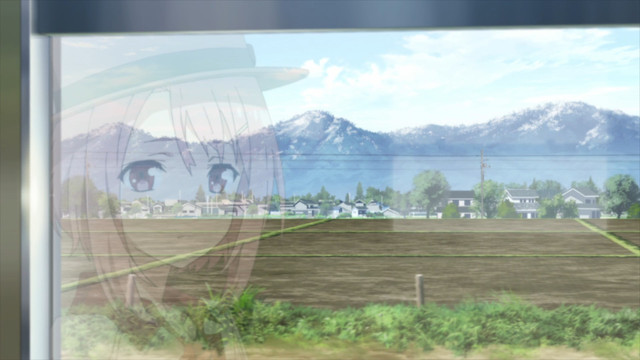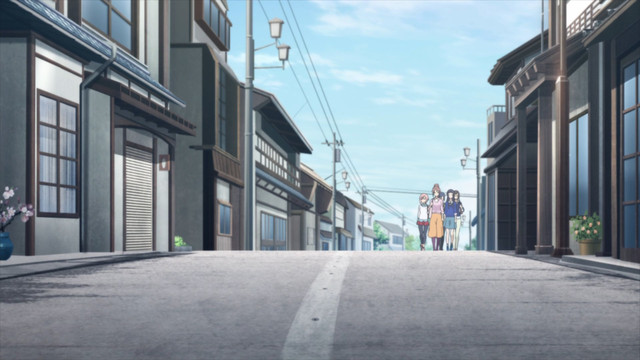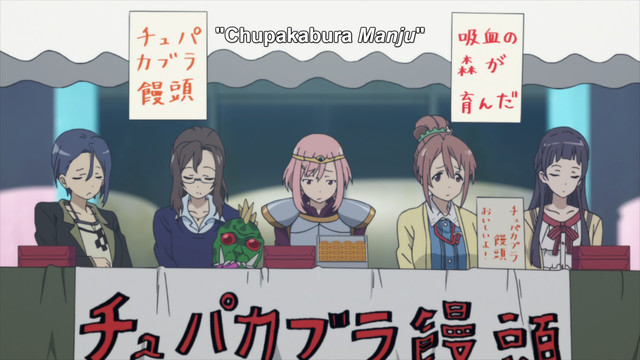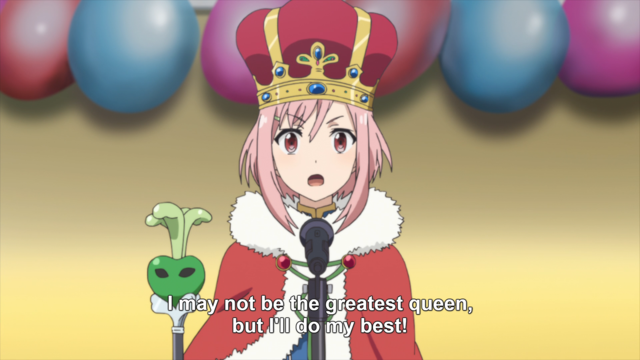Sakura Quest’s first episode introduces us to Yoshino Koharu, a young woman just on the verge of graduating from college. Having been turned down by over thirty potential employers, she’s at the end of her rope. A fortune teller informs her she’s due for great fortune in her golden years, but that doesn’t really help her now. With the economy shrinking and her own parents urging her to come home from the big city, Yoshino feels like she has nowhere left to turn. Eventually, she’s conscripted to be the “queen” of Manoyama, an imaginary tourism board title invented for a fading rural town. And so Yoshino’s bright young aspirations run aground on the rocks of reality, marooning her in the same kind of dying old town she’d just escaped.

Sakura Quest is a funny show with lots of endearing characters, but the world it constructs is painfully real. Manoyama exists in the shadow of Japan’s ‘90s boom, where bright economic prospects led to the creation of tourism boards, amusement parks, and many other properties that assumed a wealthy citizenship. When the boom ended, these artifacts were left as relics, and now the image of an abandoned amusement park stands as an evocative symbol of the country’s fortunes, popping up in properties as different as Kemono Friends and Spirited Away.
Yoshino’s own reaction to this fading world is a natural one: she wants to get away. Her exodus from her own home town to Tokyo is a familiar story, leading to a glut of rural villages that grow older even faster than Japan’s generally aging population. Yoshino’s idea of Tokyo seems like a destination from a fairy tale - it’s a place of “opportunity,” but that opportunity only exists in vague, aspirational terms. When she arrives, she’s surrounded with disappointment, and the only job she can find involves trekking right back out to save a different rural village.

Manoyama’s very architecture echo the fatigue of the times. The town is defined by faded and closed-up storefronts, and only the farmlands that have weathered boom and bust alike seem unaffected by the death of tourism. The mythical land of the chupacabra, their desperate bid for UMA-fad relevance (UMA stands for Unidentified Mysterious Animal), suffers the worst of it. The chupacabra mascot itself replaced “Kabura Kid,” a mascot chosen for Manoyama’s very unassuming chief export. And now both mascots stand as fading relics themselves - while Yoshino’s memory of loving this place is preserved in photograph, the actual icons of those times have been relegated to garbage dumps and dusty community centers.
The people of Manoyama understand that their town is dying, but what can they do? When Yoshino takes to the streets in order to find something to sell the town with, she’s met with suspicion and resignation. The concept of the Kabura Kid and the chupacabra are a fair enough articulation of what tourism has done for them - not only were both ventures unsuccessful, but they didn’t even represent the town in any meaningful way. This is just a town where people live. They’ve lived here for a long time, and they know things aren’t going well, but that’s just how life goes these days. If their businesses can hold up until it’s time to retire, they’ll have done their part - the future is bleak, but it’s no single person’s responsibility to save the world.

At the end of Sakura Quest’s third episode, Yoshino finally acknowledges the difficulty of her task. While her tourism board associates bicker over which mascot to present at a dingy local competition, she exclaims that the actual mascot doesn’t matter. Neither of these mascots were dear to the people of Manoyama - they were gimmicks, ideas created in order to play into fads that have themselves lost their relevance. No one is going to mourn the Kabura Kid.
Yoshino acknowledges that fact, but doesn’t have a different answer. How could she? She just arrived in Manoyama a few days ago, and all she’s learned so far is that the town is on its way out. When Yoshino questions what about Manoyama “stands the test of time,” it seems like an impossible question - after all, the town itself doesn’t seem likely to survive all that long. She is speaking to an audience of old souls with old habits, and all she can offer them is “I’ll try to find that special thing. I’ll do my best!”

Yoshino’s answer is unsatisfying, but that’s just how it goes. Yoshino Koharu is not going to solve a global economic downturn, or halt the aging and depopulation of Japan’s rural communities. She has no clear answer, but she’s not giving up. I’m okay with that answer, personally. I think not knowing but not giving up is the best our generation can probably do. The world is a dark and formidable place, but we still have our strength, and we still have each other. In the end, Yoshino’s pledge to find the heart of Manoyama comes with a condition - that she can do it with the other four young women she’s come to know, and who she believes can support her on the way. Maybe none of us are strong enough to solve the world’s problems. But we can at least keep fighting together.
-----
Nick Creamer has been writing about cartoons for too many years now, and is always ready to cry about Madoka. You can find more of his work at his blog Wrong Every Time, or follow him on Twitter.
No comments:
Post a Comment